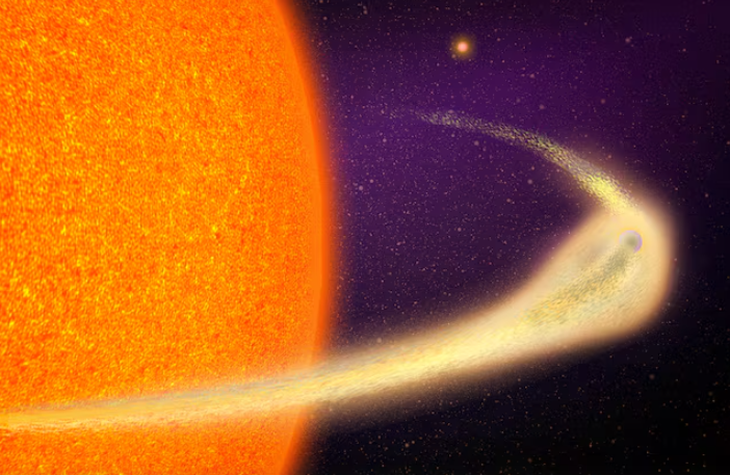Illustration of the disintegrating exoplanet BD+05 4868 Ab - Photo: Jose-Luis Olivares, MIT/REUTERS
According to astronomers, BD+05 4868 Ab is a small rocky planet, located about 140 light-years from Earth, hidden in the constellation Pegasus.
BD+05 4868 Ab is smaller than Mercury but larger than the Moon, and orbits an orange dwarf star - a smaller, cooler, and dimmer cousin of our Sun.
Despite having only 70% of the mass and diameter, and 20% of the brightness of the Sun, the host star is still hot enough to scorch the planet's surface at extremely close range - just 1/20th the distance from Mercury to the Sun.
Every 30.5 hours, BD+05 4868 Ab completes a "death" rotation around its host star. During each of these cruel rotations, the planet "sheds" a huge amount of material, equivalent to the mass of the majestic Mount Everest, drawing a giant trail of mineral dust, winding around the star like a fragile silk strip gradually disappearing into the vast space.
The surface temperature of BD+05 4868 Ab is estimated to be up to 1,600 degrees Celsius, enough to turn the entire outer shell of this planet into molten lava. Under the influence of the terrible heat, the material on the surface evaporates, forming tiny dust particles that drift in space and gradually cool, creating a magical "comet tail".
"We predict that this planet will completely disintegrate in about 1 million years - a blink of an eye in cosmic time," said Marc Hon, a postdoctoral researcher at the Kavli Institute for Astrophysics and Space Studies at the Massachusetts Institute of Technology (MIT) and lead author of the study published in the Astrophysical Journal Letters .
What is remarkable is that this “destruction” process is happening at an ever-increasing rate. “As more of the planet’s material turns to dust, the rate of disintegration accelerates,” Hon explains. “This is an irreversible process – a predicted death in the universe.”
The team has yet to determine the exact mineral composition of the dust plume, but they estimate the size of the dust particles to range from the size of large soot particles to fine sand grains.
This "dying" planet was discovered using the transit method - measuring the dimming of the star when the planet passes in front of it, thanks to NASA's TESS space telescope.
In the coming time, the research team will use the power of the James Webb Space Telescope to conduct a deeper analysis of the chemical composition of the dust tail. This is considered a rare opportunity for humans to "see through" the internal structure of a rocky planet outside the Solar System, from the crust, mantle to the core.
Read moreBack to Topic Page
Back to topic
VNA
Source: https://tuoitre.vn/quan-sat-duoc-ngoai-hanh-tinh-hap-hoi-voi-duoi-sao-choi-dai-9-trieu-km-2025042410455606.htm



![[Photo] President Luong Cuong presents the 40-year Party membership badge to Chief of the Office of the President Le Khanh Hai](https://vphoto.vietnam.vn/thumb/1200x675/vietnam/resource/IMAGE/2025/5/19/a22bc55dd7bf4a2ab7e3958d32282c15)

![[Photo] Panorama of the Opening Ceremony of the 43rd Nhan Dan Newspaper National Table Tennis Championship](https://vphoto.vietnam.vn/thumb/1200x675/vietnam/resource/IMAGE/2025/5/19/5e22950340b941309280448198bcf1d9)
![[Photo] General Secretary To Lam attends the conference to review 10 years of implementing Directive No. 05 of the Politburo and evaluate the results of implementing Regulation No. 09 of the Central Public Security Party Committee.](https://vphoto.vietnam.vn/thumb/1200x675/vietnam/resource/IMAGE/2025/5/19/2f44458c655a4403acd7929dbbfa5039)

![[Photo] Close-up of Tang Long Bridge, Thu Duc City after repairing rutting](https://vphoto.vietnam.vn/thumb/1200x675/vietnam/resource/IMAGE/2025/5/19/086736d9d11f43198f5bd8d78df9bd41)















































































![[VIDEO] - Enhancing the value of Quang Nam OCOP products through trade connections](https://vphoto.vietnam.vn/thumb/402x226/vietnam/resource/IMAGE/2025/5/17/5be5b5fff1f14914986fad159097a677)



Comment (0)